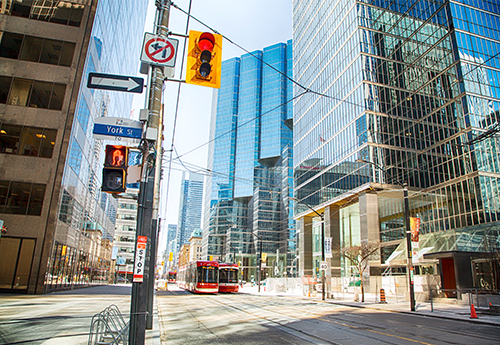Despite the “Great Lockdown”, Canadian office sublet space growth is in check (for now)

Economic downturns typically breed growth in sublease space in the commercial real estate (CRE) sector, but we can all agree that this downturn is like no other, and the outcome is unpredictable.
An analysis of new office sublet listings in Canada's major CRE markets through the first week of May 2020 reveals that a much-discussed potential spike in listings resulting from the COVID-19 pandemic has not occurred – yet. While this will certainly change in the coming weeks and months, the following highlights will serve as a benchmark from which to measure the full effect of the pandemic:
- More than 9.3 million square feet (msf) was available for sublease as of the first week of May, leaving the national sublet availability rate at 1.9% – similar to one year ago
- Sublet available space as a proportion of total available space stood at almost 17% – up from 15% one year earlier
- By comparison, heading into the 2008-2009 Financial Crisis, there was half as much available sublet space – equating to 1.1% and representing almost 16% of total available space at that time. During that crisis, sublease space increased for six consecutive quarters (Q4 2008 to Q1 2010), adding more than 4.5 msf between trough and peak
- Across Canada's major markets, the number of new subleases marketed in the month of April (89) represented a slight decline compared with the previous three months
- April's new listings also totalled slightly less square footage (738,000 sf) compared with March's total (767,000 sf), though higher than January and February
- In all, 395 new sublet spaces, representing almost 3 msf were brought to market between January 1st and May 6th

- By size range, spaces less than 5,000 sf represented 55% of the number of spaces, while those of 10,000 sf and up represented 24% of spaces but 63% of total square footage
- The average size of new sublet spaces was 7,400 sf. Calgary posted the highest average sublet size (16,400 sf), while Montreal and Ottawa tied for the smallest average size (4,900 sf)
- Sublets in class A buildings made up the bulk of the total, accounting for 50% of the number of spaces and 71% of total square footage listed
- On average, class A sublets were the largest at 10,400 sf, while class B spaces averaged 4,700 sf and class C spaces 3,600 sf
- By market, Toronto and Vancouver posted the highest number of new spaces (172 and 110, respectively), while Toronto (1.1 msf) and Calgary (967,000 sf) posted the most total square footage listed – each accounting for more than one-third of the national total
There is a lot of discussion in the marketplace about upcoming sublease listings, many of which have likely not yet been marketed due to the logistical difficulties (such as touring spaces) that would arise and the reluctance of potential subtenants to transact amid the uncertainty of the pandemic. As restrictions are lifted across the country, more listings may come to market and only then will the true extent of the phenomenon become apparent.
-
 World Economic Forum, Davos 2024: Key Insights for the Commercial Real Estate Industry 31-Jan-2024 2:36:00 PM
World Economic Forum, Davos 2024: Key Insights for the Commercial Real Estate Industry 31-Jan-2024 2:36:00 PM -
 Opportunities arise in a downturn for North Carolina tenants and beyond 27-Mar-2020 9:41:00 PM
Opportunities arise in a downturn for North Carolina tenants and beyond 27-Mar-2020 9:41:00 PM -
 Avison Young completes acquisition of U.K.-based GVA; two companies combine under Avison Young name and brand 8-Feb-2019 11:12:00 PM
Avison Young completes acquisition of U.K.-based GVA; two companies combine under Avison Young name and brand 8-Feb-2019 11:12:00 PM -
 Toronto – A Development Retrospective 28-Feb-2019 11:16:00 PM
Toronto – A Development Retrospective 28-Feb-2019 11:16:00 PM -
 Fourth Annual Apartment Renter Survey Results 18-Nov-2019 8:55:00 PM
Fourth Annual Apartment Renter Survey Results 18-Nov-2019 8:55:00 PM -
 Distressed assets? Not yet… 16-Feb-2021 1:30:00 PM
Distressed assets? Not yet… 16-Feb-2021 1:30:00 PM
